An example of good public school education

Those who are regular readers of this webpage know that I generally have a low opinion of the American public school system, based on ample evidence. It generally fails to educate while working to abuse and indoctrinate young children in ways that are so ugly and inappropriate that often the administrators and teachers involved could actually be charged with child abuse.
Today I am instead going to provide an example of a public school doing right by its students. On Saturday I was invited to watch as an afterschool engineering group, run by John Morris, the Engineering & Mathematics teacher at Casa Grande Union High School in Arizona, went out to launch model rockets that they had built themselves.
The launch to the right was the first of the day. The rest of the post below is image oriented, to give you a feel of what it involved in teaching young high school students how to make and launch small rockets. That activity, while involving relatively simple engineering, provides them the right grounding for learning how to work hard, make sure they do the work right, and learning that failure is really only a step towards success.
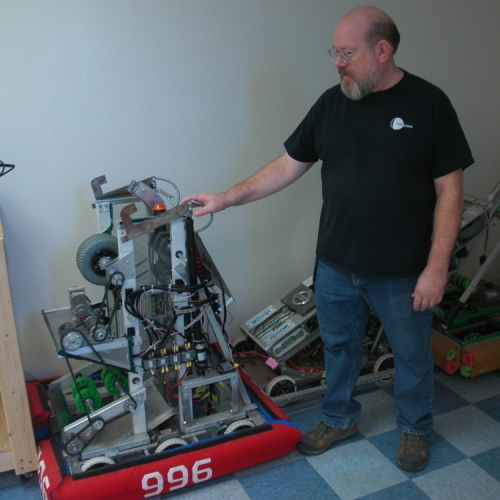
John Morris
Morris not only teaches at the school, he runs an extensive afterschool program for students, including a club helping girls learn computing, a club for competing in robotic competitions, and a chapter of Students for the Exploration and Development of Space (SEDS). To the right he stands next to a robot built by his students in 2020 that unfortunately they never were able to show off because the 2020 robot competitions were all cancelled. Those students have all now moved on to college, and thus their robot sits unused and abandoned in Morris’s workshop. They never had a chance to test it in competition, to see if their design worked as well as they hoped.
Morris’s goals are straightforward. His classroom is plastered with inspirational posters and historical photos of past great space achievements, all aimed at inspiring his students to focus on being the best they can be. For example, he also runs a four year program, as he wrote me, “designed to prepare my students to be successful in their first year at university as an engineering major.”

Even, Sean, and Dylan repairing rocket parachutes
His workshop is quite impressive. It includes a somewhat complete machine shop for shaping small metal and plastic parts, as well as a classroom and assorted additional rooms in which the students can work. Above is the main room, with students (left to right) Evan Centeno, Sean Price and Dylan Benavente at work prepping their rockets for the day’s launches.
The day started at the workshop, where the students first did some final fixes and tweaks to get their rockets ready. Then we all got in cars to drive about ten minutes to a wide open desert field, far from any buildings, where Morris had obtained the right permits for them to launch their rockets.
As this is central Arizona, finding such a place is easy, which is why the launch site was so close, practically in the middle of Casa Grande.
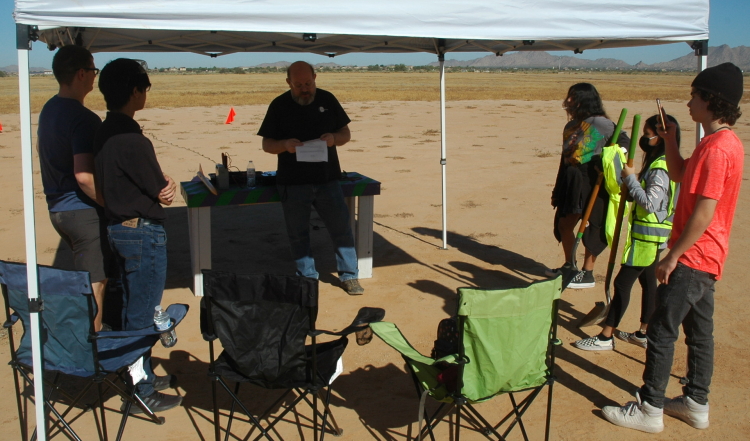
After some quick set up, Morris gathered the students to review the safety rules. Sean and Dylan are to the left, Lynette Chavez, Sophia Jorda, and Evan are to the right. Behind Morris you can see an electric cord running out to a spot about fifty feet away, about where the red warning flag is placed. The launch tower itself, not visible in this picture, is a thin antenna-like post that is used to guide the rocket vertically upward. At its base is an angled blast wall, designed to direct the blast away from the ground and the equipment.
Lynette and Sophia hold shovels. For the first launch (the first picture above), they positioned themselves about twenty feet to either side of the launch tower ready to shovel dirt on any fire that might start. Once they saw the launch site was safe, it was their job to chase after the rocket and recover it.
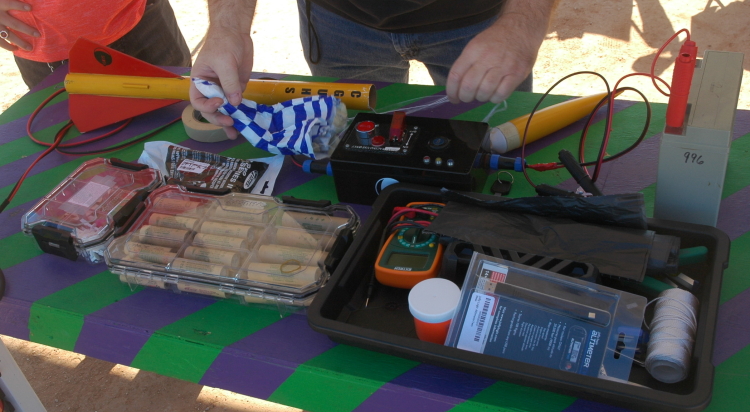
Next Morris demonstrated how to assemble a rocket for launch. First he put two to three pieces of fire retardant wading into the top end of rocket body. This protects the parachute from the rocket flames below. Next he inserted a data logger, followed by the chute, carefully folded so that it will release cleanly.. The nose cone is then inserted.
Next he inserted one of the brown solid rocket motors into the aft end of the rocket, then inserted the leads of an electronic igniter into this. The rocket was ready to launch.
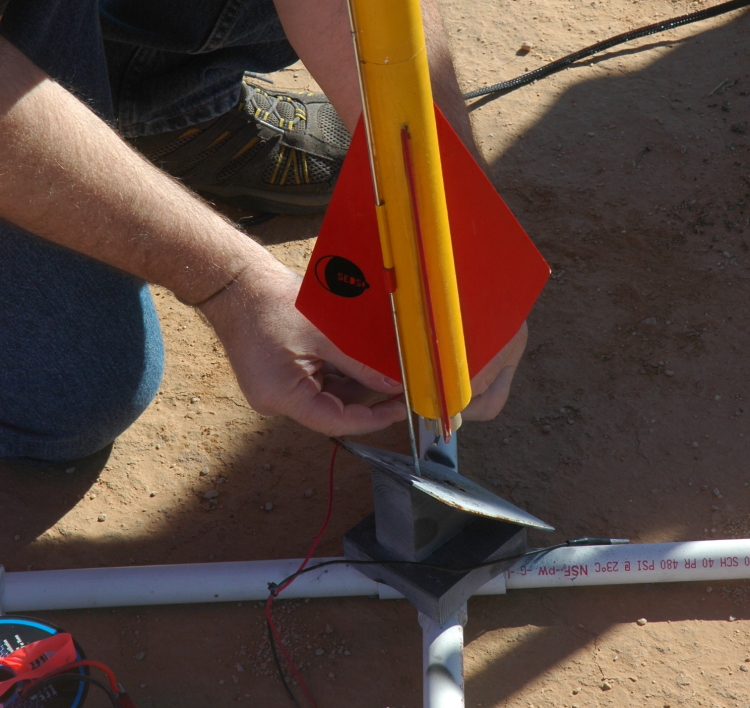
The rocket body has a tiny sleeve tube on its side. At the launch tower Morris slipped the antenna wire through this so the rocket is held vertical, and then attached two alligator clips to each of the leads. When everyone was safely away and in position, Evan turned the ignition key on the igniter box, switched on the ignition button, and called out, “T-minus 5…4…3…2…1….ignition!” and pressed that button.
If ignition goes right — which it did in this case — the rocket’s solid rocket motor ignites, and the rocket lifts off, reaching heights ranging from about 600 to 1000 feet, depending on the size of the solid rocket motor used.
Sometimes however there is a misfire. You press the button and nothing happens. After waiting a minute or so, the safety officer, which was Morris, would go out to figure out what went wrong. The one misfire that occurred later in the day was caused when the leads inserted into the motor had accidently become crossed, short circuiting the electric igniter so that it would not ignite the motor. The student inserted a new electronic igniter and tried another launch with the same rocket, this time successfully.
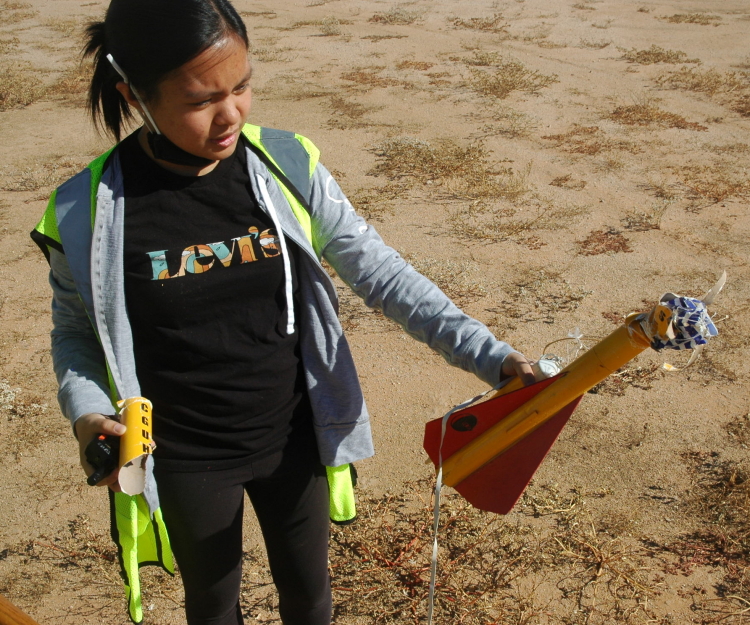
That first launch had its own problems. While the launch went well, when it came time for the nose cone to separate to pull the parachute free to gently lower the rocket to the ground, the chute did not release. The rocket came crashing to the ground. Sophia above holds the recovered broken rocket parts.

In looking at the damaged rocket, Dylan immediately proposed a preliminary explanation. Note the opening to the right of the parachute. At this point on the rocket body are drilled tiny holes to allow the outside air to reach the data logger, so its sensor could work. Dylan suggested that this rocket, which they had been using for more than a year and had already flown many times, had become weakened at that point. When the rocket fires the inside pressure builds, and that pressure blew out here. The blast not only damaged the chute, the lose of pressure meant that it was not there to push the chute out so that it could unfold.
Morris pointed out that this made sense, but that further analysis however was necessary. They would do that at the workshop later.
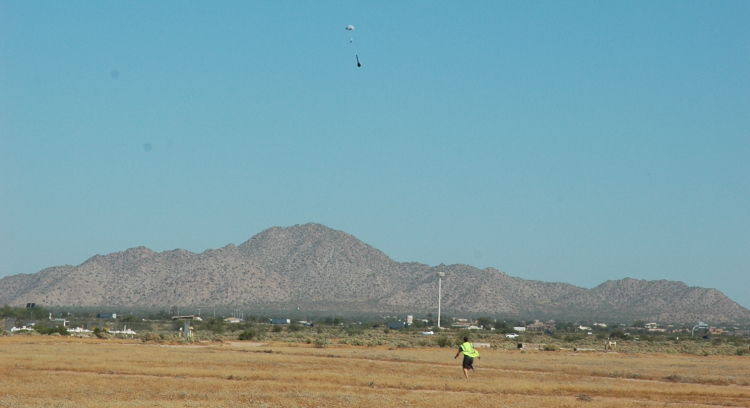
The students each then launched their rockets, one by one. Above you can see Evan running madly to try to catch Sophia’s rocket before it touched the ground. Though the chute had opened successfully, catching it would further reduce the chances of damage. He succeeded. As Morris noted to me, “He’s also a soccer player, so he’s got plenty of wind.”
The last two pictures below show Morris firing one rocket, and the second launch of Sophia’s rocket, this time assembled and launched by Lynette.
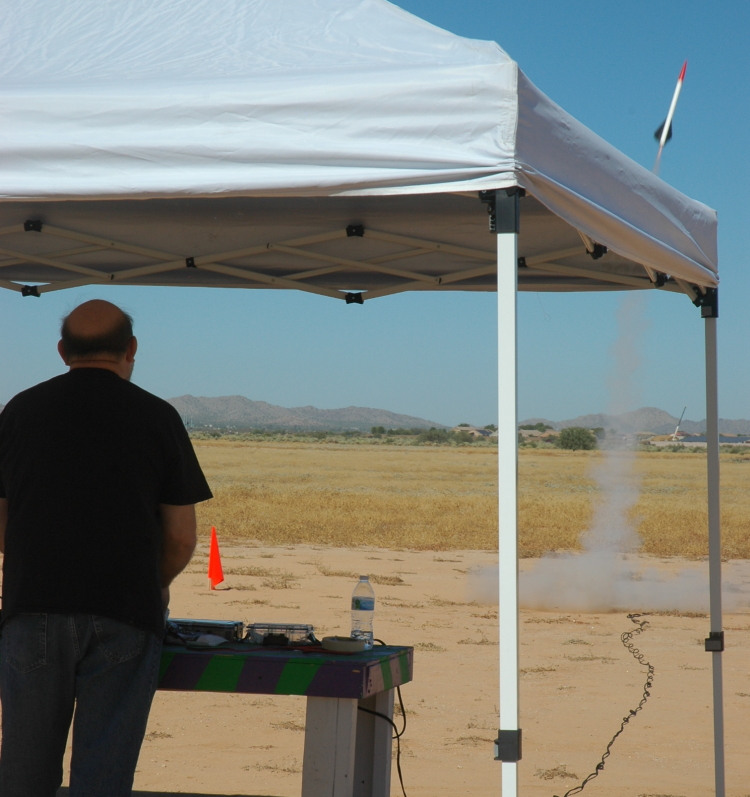

It is hard to describe the feeling of exhilaration I felt watching these rockets shoot into the sky. They quickly zoomed far above us so that I found it impossible to get a good picture at their highest point. For the students, who built the rocket body and then assembled and fired it, the feeling must have been far more satisfying.
This day’s activities were only a small sample of Morris’s program. For example, Sophia and he had just returned from a workshop in Colorado, where she has been accepted as one of the participants in an international student project to put 500 separate sensors on the Moon by 2023. She had been given a kit from which she will assemble two sensors, configured by her.
That project is taking advantage of NASA’s decision to harness capitalism in space. While it has not yet finalized the lander it will use, the project now has a plethora of privately-built such landers to negotiate with. I suspect they have not finalized their choice because they want to wait and see which of the first private lunar landers succeed.
Morris’s students also compete in robotic competitions, as described above, as well as work on student satellite projects. All in all, he is exposing them not only to new knowledge, but it is not book knowledge, but applied knowledge, learned skills that the students immediately use and test. If they do it wrong, it teaches them the importance of getting it right. And if they do it right, they see themselves create something truly wonderful.
Or as Morris says in the signature line of his emails, “Dare mighty things.” He is giving his students the opportunity to learn how to do exactly that.
On Christmas Eve 1968 three Americans became the first humans to visit another world. What they did to celebrate was unexpected and profound, and will be remembered throughout all human history. Genesis: the Story of Apollo 8, Robert Zimmerman's classic history of humanity's first journey to another world, tells that story, and it is now available as both an ebook and an audiobook, both with a foreword by Valerie Anders and a new introduction by Robert Zimmerman.
The print edition can be purchased at Amazon or from any other book seller. If you want an autographed copy the price is $60 for the hardback and $45 for the paperback, plus $8 shipping for each. Go here for purchasing details. The ebook is available everywhere for $5.99 (before discount) at amazon, or direct from my ebook publisher, ebookit. If you buy it from ebookit you don't support the big tech companies and the author gets a bigger cut much sooner.
The audiobook is also available at all these vendors, and is also free with a 30-day trial membership to Audible.
"Not simply about one mission, [Genesis] is also the history of America's quest for the moon... Zimmerman has done a masterful job of tying disparate events together into a solid account of one of America's greatest human triumphs."--San Antonio Express-News


Always nice when a teacher is active in lighting a fuse in young minds
I did my own 26 years of lighting fuses.
No more. There’s no way I would again be the only adult in the immediate vicinity of any group of underage persons who on an off day would go to some other adult and say I touched them inappropriately.
The urge to be a Hero to the kids isn’t worth the risk of being accused of sinister intent.
Their willingness for implicit loss of insight doesn’t have to volunteer me to be their ‘loser’.
They’re kids. I don’t believe they possess the wherewithal to automatically dislike Hero builders.
I do believe that there are more adult-like malevolent forces behind the driving of Hero-builders out of public life.
Would have loved to had a “John Morris” when I was in school. Great write-up and a good reminder that there are still some good role-model educators out there.
Our 9th grade science teacher had us build and launch model rockets, ostensibly as an introduction to trigonometry (how high did it go?), but being teenagers, we quickly wanted to see how high we could get it. The smallest motor allowed a few seconds of hover over the launch pad; interesting, but unproductive. I believe we crammed a ‘D’ motor in, and never saw the rocket again.
Robert wrote: “In looking at the damaged rocket, Dylan immediately proposed a preliminary explanation. … Morris pointed out that this made sense, but that further analysis however was necessary. They would do that at the workshop later.”
Wow! First hand failure analysis. That is something you usually don’t get in high school.
For many years I was a model rocket enthusiast. What I learned about center of pressure, center of gravity, and drag force, in designing and flying rockets was both instructional and fun. The rocket motors come with what is called an “ejection charge” that is located in the top of the motor and Estes always gave you at least 2 options for the delay on that charge if not more. One of my favorite motors was the C6-5. So the letter class gives you the power rating, so 4 A motors = 2 B motors = 1 C motor etc. The second # IIRC was the average thrust rating which gave you an idea of how fast the fuel would be burned in that engine. And the third # was the ejection charge delay in seconds. I would assume that putting holes in the body tube would vent some of those gasses and might cause the parachute, if packed tightly, not to deploy properly. Fun stuff . . .
I do that every year in the spring for the kids at the parochial school my wife teaches at, and before that when I was still involved in Scouts, I did the Space Ex merit badge every year. I always require them to build a scratch kit instead of the ready-to-fly kits and will also bring out some of my more advanced models. to show off. The big rockets using F and G engines, multi stage, glider/helicopter recovery, and clustered are big hits.
The kids have fun and the adults have a blast too (pun imntended!).
This teacher is a keeper. He launches rockets and is a mentor of the school’s FIRST robotics team. He is a diamond in the rough and I hope he does not get ran down by the school’s administration.
I almost got into rocketry as a kid through my fifth grade class, but the teacher quit doing it because he blew out his knee and taught anatomy instead. Like t-dub, I did not get into rockets until I was an early teenager, launching with my friends. I never found the rocket I built with the D-engine booster and second stage with the C-engine!
It wasn’t until high school that I had a physics teacher that did everything- electronics, ham radio, rockets and physics olympics (his creation using the M.I.T. competitions that use to air on PBS). Got to use trig to measure the height of the rocket. He retired from teaching early since he was tired of the administration trying to dumb down his classes.
I built and flew many model rockets in my junior-high and early high-school years. It was the first place where, like Blair, I first learned about trigonometry in the service of altitude measurement … and my first experience with mail-order, direct from Penrose, CO. And I loaded up at least a couple of rockets – as I remember, a featherweight “Streak” and a 3-stage “Farside” – with the maximum (C) engines they would take, and launched them to never be seen again.
Also, in the absence of experienced guidance, I did a few foolish things …. such as building a rocket out of toilet-paper tubes and using regular TP as recovery wadding; neither of these materials being flame-retardant. I got away with that without burning down the field … but a slightly harder mistake was trying to launch a D engine out of a tube, bazooka-style – and got my face peppered with exhaust as the engine exited the tube and tumbled. That, in hindsight, was close to a “hold my beer and watch this” moment.
That being said, model rocketry contributed to the science education that I carried into engineering school and beyond … even to the point that, 45 years after I launched my last one, I was called upon to install the fins on my young grandsons’ rockets they launched (with serious adult supervision) as part of their Cub Scouts activities.
Thanks for sharing this story. What a great teacher,& despite some reserve in another comment, and mentor. Exposing young minds to complex problems is fantastic in encouraging problem solving. Higher level thinking makes for an enthused engaged student- interesting he also prepares the students for success in college engineering. As a homeschool mother we did tons of science & my husband taught our children, their friends & assorted Scouts Rocketry. A blast was had by all?
Great post! I love launching Estes rockets with my son as well, and here’s a video of the great footage you can get by simply taping a $50 camera onto the side of the rocket: https://www.youtube.com/watch?v=vdjwD-AuHzI
And if you’d like to see more of my posts on Substack, I’m at https://paultaylor.substack.com/
Very nice! Thank you for sharing this!
I did model rockets as a kid, and I introduced them to a homeschool co-op engineering class when I guest taught there.
Lots of fun, for kids who want to put in a little time and effort.
Thanks for this post Bob. I have always loved building and launching model rockets. I’ve done it, since I was in 7th grade. Today, I am a Scout Leader and teach the Space Exploration Merit Badge. As a part of earning the merit badge, the kids have to know the pieces and parts of a model rocket, and then build, launch, and recover a rocket. The kids always love doing this. We even touch on Mr Newton’s laws, how actual rocket engines work, along with planetary and manned mission history. All of it is good stuff, and they learn a lot.
Nice model from here
https://up-ship.com/blog/?p=53340
“My 3D printed scaleup of the model I created for Fantastic Plastic is coming along. I’m approaching this as more of an art project than engineering… partially because I think it better fits the aesthetics of a 1920’s “project” by painting it with rattlecans and pens rather than an airbrush, partially because I just want to see how it turns out. So far, I think it’s pretty good. Mostly done, some more bolts and weathering to add, then ‘ll declare victory. What then? I’m torn between hanging it on the wall and putting it on ebay. If it goes for a good price on ebay I think I’ll revisit it… give the next iteration actual transparent windows and a full interior, crew, passengers, tanks.”